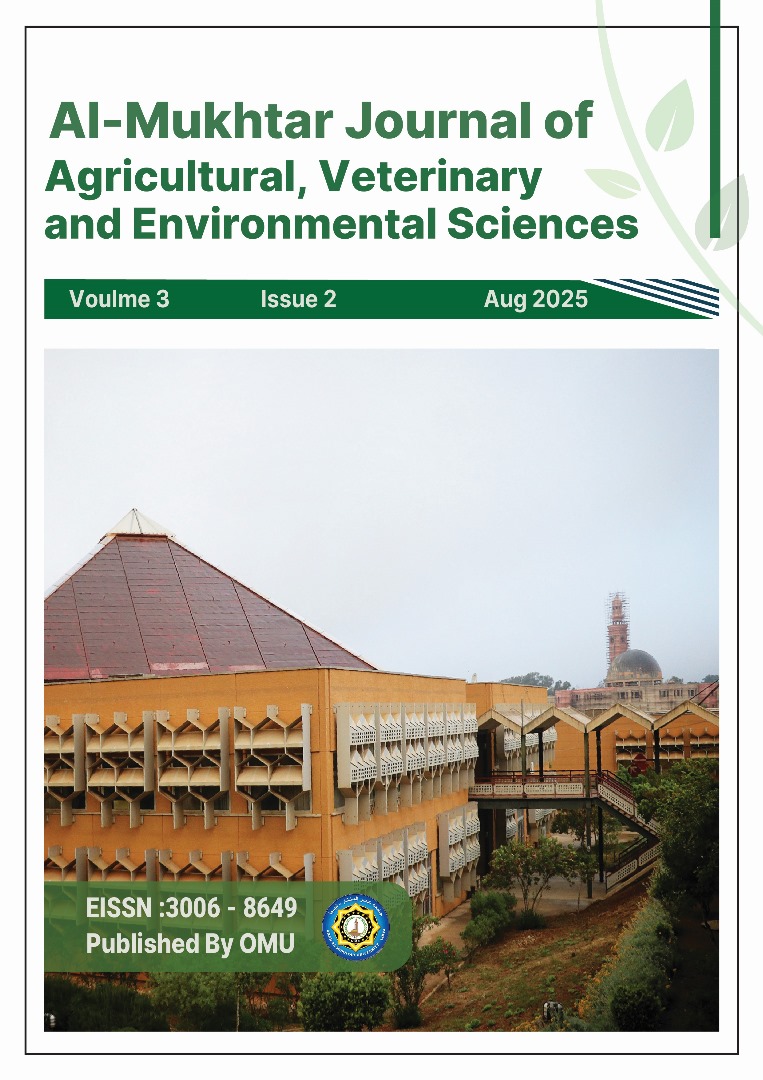Evaluation of Vegetative Growth Efficiency of Kabuli Chickpea under the Interaction of Plant Density and Weed Management Systems in Al-Safsaf Area, at EL-jabal Al-Akhdar
DOI:
https://doi.org/10.54172/ked1ax35Keywords:
Kabuli chickpea; growth traits; plant density; weed hoeingAbstract
Two field experiments were conducted during the 2021 and 2022 seasons at the Food Legume Research Station, Al-Safsaf – EL-jabal Al-Akhdar, to investigate the effect of plant density and weeding frequency on the physiological growth traits of the Kabuli chickpea. A split-plot design with four replications was used, with plant densities (9.52, 13.33, 20.0, and 33.33 plants/m²) in the main plots and weeding treatments (no weeding, one weeding, and two weeding's) in the subplots. Results showed that plant density significantly affected germination percentage and emergence rate index, with higher densities performing better, while no significant differences were detected in mean emergence time, seedling dry weight, plant volume, or canopy persistence. Leaf area, leaf area index (LAI) index, and persistence varied across seasons depending on density. Conversely, two weeding's significantly enhanced seedling dry weight, plant volume, canopy persistence, and leaf area traits. The interaction between plant density and weeding frequency was highly significant for most traits in both seasons. Overall, plant density influenced traits related mainly to germination, whereas weed management played a greater role in improving vegetative growth and canopy sustainability. The interaction between these two factors represents a key strategy for optimizing vegetative growth efficiency of Kabuli chickpea under rainfed conditions.
Keywords Kabuli chickpea; growth traits; plant density; weed hoeing
References
حسين، طيب فرج، بوهدمة، أحمد سالم ونوح، طارق عبد الرحمن.(2020 ). تحفيز الأحماض العضوية لإنبات وتطور بذور بعض المحاصيل البقولية، مجلة البيان العلمية. (5): 31- 40.
Alka, S.,and Namrata, J. (2017). Integrated weed management in chickpea. Indian .J. Weed Sci. 49 (1): 93-94.
Beech, D.F., and Leach, G.L. (1989).Effect of plant density row spacing on the yield of chickpea CV. Tyson , grown on Darling Down, south eastern Queens land . Aust. J.EXP. Agric, 29(2):241-246.
Brix, A, and Andreasen, C. (2000). The relative between densities and frequencies of weeds in ar-able fields. J. Agric. Biol. Envron. 5: 372-586.
Bulti, M., and Nano, A. (2019). Integrated weed management in chickpea (Cicer arietinum.L) Co-gent Food and Agriculture. (5):1-18.
Bonham ,C.D. (2013). Measurements for Terrestrial vegetation. Hoboken, N.J: John Wiley & Sons publishing.
Carita, L. A. Gullherme, B. F. ; Campos, M. P., and Perdro, L.D. (2018). Periods of weed interfer-ence in chickpea grown under different doses of nitrogen fertilizer top dressing. Acta sci-entiarum Agronomy ( 4):2-10.
Naim, A. H.; Abdelkarim, H. A., and Sershen, F.A. (2017). Effect of irrigation regime and plant density on chickpea yield in the Semiarid environment of sudan . Asian plant. Sci. Res. 7(6):142-151.
Nigssu,B., and Tesfaye,G.(2021).Influence of intra and inter raw spacing on seed yield and yield component of chickpea varities in central higlands of Ethiopia .Int.J.Novel Res in life sci-ences 8(5):23-30.
Tatek, T.; Walelign, W.; Worku, M., an d Getu, W. (2020). Response of chickpea (Cicer areitinum L.) genotypes to intra and inter row spacing at Huletegna Choroko Southern Ethiopia. Ecology and Evolutionary Biology. 5(4): 148-158.
Thangwana, N.M., and Ogola, J.B.O. (2012).Yield and yield components of chickpea Response to genotype and planting density in summer and winter sowings .J. Food Agric. Environ. (10):710-715.
Tsedeke, A. (2011). The Tropical legume : II: Project Review and planning Workshope for chick-pea in India. scheduled for 5-6. September, ICRISAT_ Patacheru Campus, Hyderabad, India.
Downloads
Published
Issue
Section
License

This work is licensed under a Creative Commons Attribution-NonCommercial 4.0 International License.













